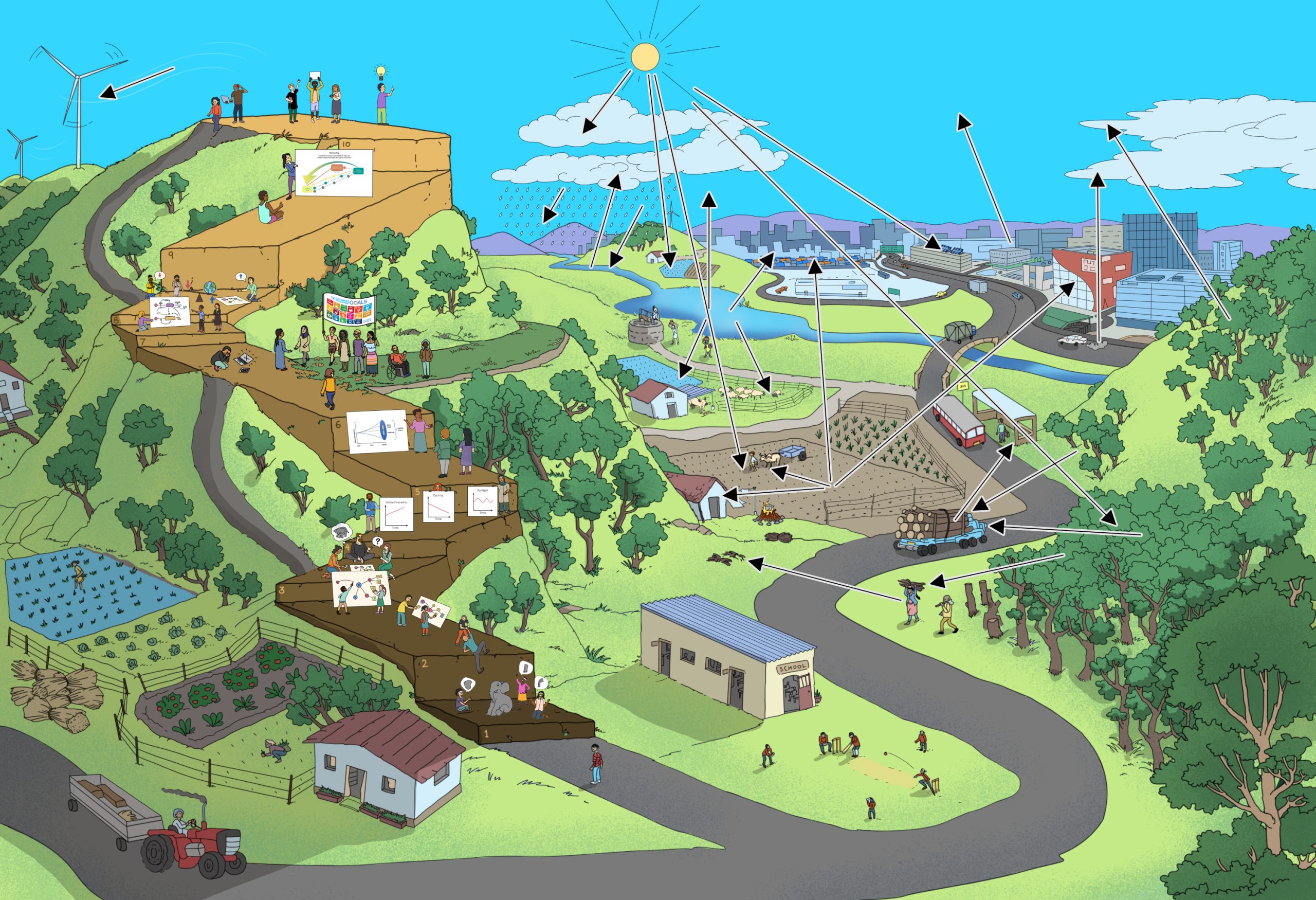Systems thinking is the ability to describe and/ or visualise a part of a complex reality, express that part of reality as a model, understand the model as a system, use the model to explain the behaviour of the system, anticipate the behaviour of the system, and evaluate its impacts on sustainable development, identify potential points of, and types of interventions, generate options to act, assess their impacts in the frame of sustainable development, and decide whether further actions are necessary or not.
1. What does this mean?
In Step 3, the learners recognized that a systems model helps to understand the functioning of the system.
In Step 4, the learners perceive that the reality or behaviour of the system at a given time is a momentary, or short term result of visible or hidden processes. The reality at a given time is like a snapshot of the behaviour of the system at that time, discerned by observing selected parameters.
For example, the health of a eutrophic pond ecosystem could easily be estimated by observing algal blooms, as compared to a chemical analysis of the water.
To understand the nature of change of the system, we have to observe several snapshots that show the patterns of behaviour over time (BOT), which may remain stable (or constant), or change over time. Change could be attributed to a combination of both internal and external drivers, and to changing contexts.
The reasons for change in the behaviour of selected parameters (and of the system itself) might be internal drivers, such as increasing demand for specific goods, or external contexts, such as culture-specific values.
Furthermore, the behaviour of a system may change in different contexts which are external to the system, or outside the system boundary, since systems are nested within larger systems. For example, a factory in one part of the world may run differently than one in another part, due to local political, climatic, and other conditions.
Generally, system structures are of two types – balancing and reinforcing with associated behaviour patterns. The analysis of the model could show balancing or reinforcing pattern or behaviour.
- Balancing behaviour means that contrary flows neutralize each other.
- Reinforcing behaviour means that different flows come together and strengthen an effect.
The system as a whole may display one or the other behaviour at a given time, while both behaviours may be present within a system, in different subsystems.
You may introduce this example of a model of ‘product adoption’.
Model of product adoption
Consider the behaviour of a society when a new product is introduced. The whole population, of say a city, could be divided into two segments: ‘potential adopters’, and those who already are ‘adopters’. In the beginning everyone is a potential adopter, and no one is an adopter. Over time, the number of potential adopters goes down and the number of adopters goes up.
Take a look at this animation of a model of product adoption illustrating how different elements (e.g. adopters, potential adopters) within a system show different behaviours over time.
https://en.wikipedia.org/wiki/System_dynamics#/media/File:Adoption_SFD_ANI.gif
2. What is the aim?
To enable learners to explain the past behaviour over time of the system.
3. Potential for competencies enhancement in this step

4. Activities, tasks and suggested learning methods
By now learners understand elements and feedback processes. Using these, how system structures result in system behaviour can be explained over time. In this step, the learners use their understanding acquired in Step 3 to explain how a single element in a given system behaves over time.
Learners may be encouraged to take up additional activities to enhance their understanding of models, by tasks such as:
- Explain a given model
- Learn how to assess the quality of a model (see the Worksheet ‘Analyse your Model’)
- Learners may review their own model developed in the previous step or a given model, and try to improve the model if needed.
The system as a whole may display one or the other behaviour at a given time, while both behaviours may be present within a system, with different subsystems.
Learning methods to support the Activity
To understand interrelationships and causation*:
- Moving Game
- Understanding Causation
* use the the water cycle model to train on how to explain a model and causation.
To communicate and make a logical argument:
Finally, the learners should develop a text or oral explanation of the past and recent behaviour of the system and certain elements, using
To explain system behaviour (presented as slides or in a flipchart):
- Behaviour over Time Graphs of the past up to the present
- Understanding Causation
- Explainer video
- Podcast
The learners may explain the system behaviour using a slide show, or flip chart or methods such as:
- Behaviour over Time Graphs
- Living Loops
- Explainity video
- Podcast
Worksheet
Analyse your Model
5. Conclusion
Reflect on what is learnt thus far, either summarizing the activity or asking some of the learners to do so. In this Step, learners should have understood that:
- Systems are dynamic
- The structure of systems determines their behaviour.
- Ask the group to think about and share further questions.
- The answers to these further leading questions may be discussed in the next steps.
6. Suggested Further Leading Questions
- Can you look into the future with the help of a system model?
- Do similar system structures produce the same pattern of change?
- Do similar system structures have the same function?
- Do similar system structures behave the same way in different contexts?

